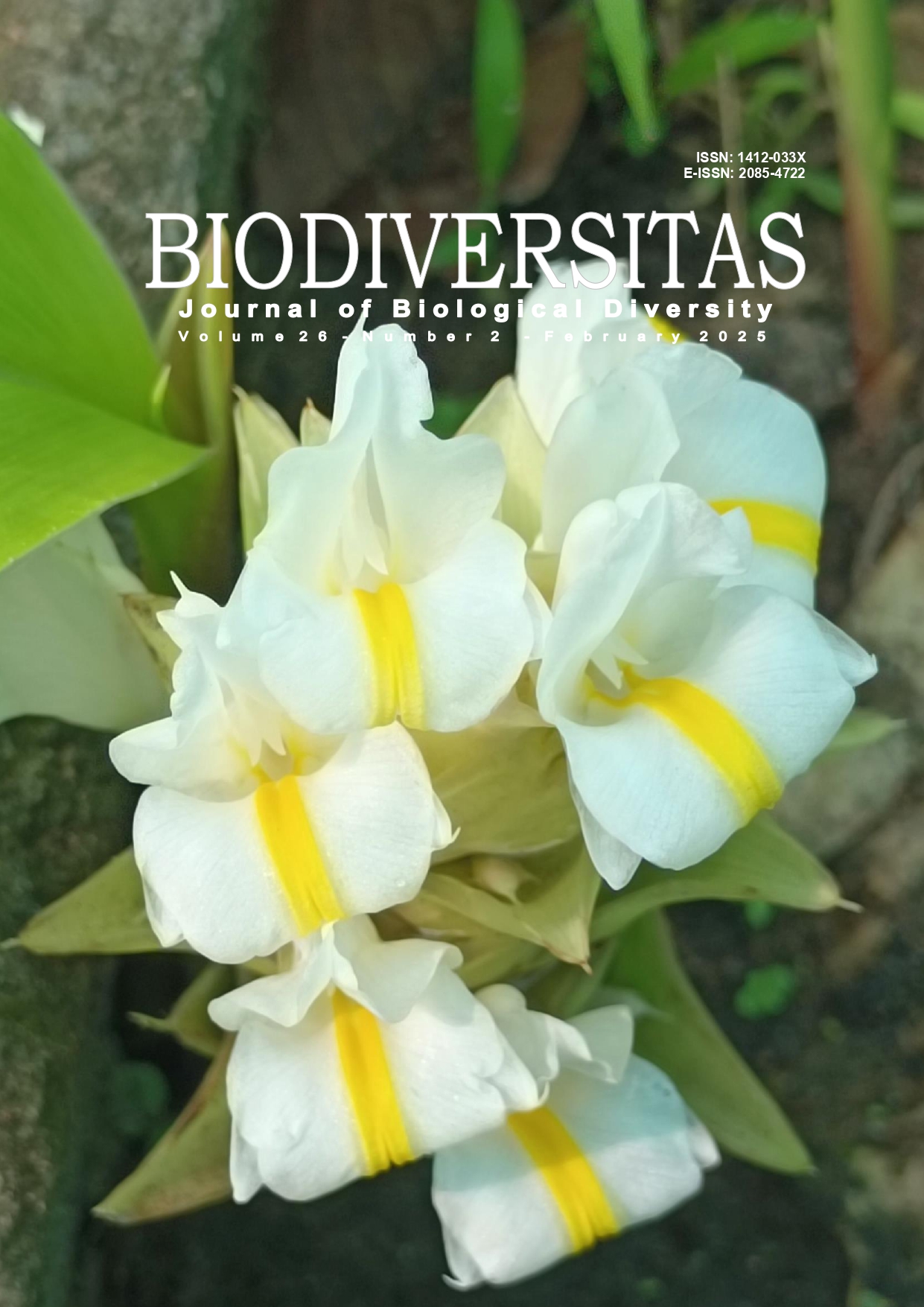Genetic diversity of Indonesian rice varieties for salinity tolerance using RAPD markers
##plugins.themes.bootstrap3.article.main##
Abstract
Abstract. Nurhidayati T, Rachmandika FCA, Jundana MQ, Rahayu AE, Herwibawa B, Saputro TB. 2025. Genetic diversity of Indonesian rice varieties for salinity tolerance using RAPD markers. Biodiversitas 26: 731-738. Rice (Oryza sativa) is essential for food security in Indonesia, but agricultural land conversion and rising salinity threaten production. Therefore, it is crucial to study germplasm collections for salt tolerance and utilize molecular markers to select resistant lines. This study investigated the potential marker for salinity tolerance using local Indonesian rice. We investigated the genetic diversity of five germplasm collections (i.e., IR64, Jeliteng, Mantap, Pamerah, and Situ Bagendit) using a molecular marker technique with Random Amplified Polymorphic DNA (RAPD). The genomic DNA was extracted using CTAB 2%. This research employed ten RAPD primers (OPA-02, OPA-10, OPA-13, OPB-07, OPC-02, OPD-08, OPI-01, OPK-20, OPU-19, OPU-20). The analysis revealed a significant level of polymorphism, producing 184 bands, of which 168 were polymorphic, indicating 100% polymorphism; notably, the OPI-01 primer exhibited 94% polymorphism. The amplified bands ranged from 250 to 1920 base pairs, with the OPC-02 primer showing the most promising results, evidenced by a PIC value of 0.431. These findings suggest that the identified RAPD markers can effectively enhance the selection of salt-resistant rice varieties. This study highlights the potential of molecular markers, such as OPC-02, that could be valuable tools for selecting salt-tolerant rice varieties and contributing to food security amidst the challenges of agricultural land conversion and soil salinity.
##plugins.themes.bootstrap3.article.details##
Most read articles by the same author(s)
- TRIONO BAGUS SAPUTRO, YUSMANI PRAYOGO, FARADIBA LAZUARDI ROHMAN, NUR HIDAYATUL ALAMI, The virulence improvement of Beauveria bassiana in infecting Cylas formicarius modulated by various chitin based compounds , Biodiversitas Journal of Biological Diversity: Vol. 20 No. 9 (2019)
- TRIONO BAGUS SAPUTRO, KRISTANTI INDAH PURWANI, DINI ERMAVITALINI, ARIF FUAD SAIFULLAH, Isolation of high lipids content microalgae from Wonorejo rivers, Surabaya, Indonesia and its identification using rbcL marker gene , Biodiversitas Journal of Biological Diversity: Vol. 20 No. 5 (2019)
- TRIONO BAGUS SAPUTRO, NUR FADLILLATUS SHOLIHAH, DINI ERMAVITALINI, Dynamics expression of Osr40c1 gene and growth of maize (Zea mays) calluses in responding to salt stress , Biodiversitas Journal of Biological Diversity: Vol. 18 No. 2 (2017)
- TRIONO BAGUS SAPUTRO, WIRDHATUL MUSLIHATIN, DWI KUSUMA WAHYUNI, TUTIK NURHIDAYATI, FILA OXI WARDHANI, ELENA ROSALIA, Variation induction of Glycine max through low dose gamma irradiation produces genetic and physiological alteration as source of tolerant variants in waterlogging conditions , Biodiversitas Journal of Biological Diversity: Vol. 20 No. 11 (2019)
- SRI NURHATIKA, DINI ERMAVITALINI, TRIONO BAGUS SAPUTRO, YUDI APRIYATMOKO, Biodiversity and characterization of high lipid content microalgae in Porong River Estuary East Java, Indonesia , Biodiversitas Journal of Biological Diversity: Vol. 19 No. 2 (2018)
- TITAH RIGEL ANJALANI, SALMA ARGYA RASMI, ANISA ESTI RAHAYU, MUHAMMAD RIFQI NUR RAMADHANI, MAY FIATUS SHOLIHAH, IRA PUSPANINGTYAS, IRO DATUS SOLEHA, SEPTI ANITA SARI, MAULIDIA RAHMAWATI, NASORI NASORI, NURUL JADID, Methyl jasmonate stimulates growth and upregulates the expression of Phenylalanine Ammonia-Lyase (PAL) gene in Gynura pseudochina in vitro micropropagation , Biodiversitas Journal of Biological Diversity: Vol. 25 No. 5 (2024)

